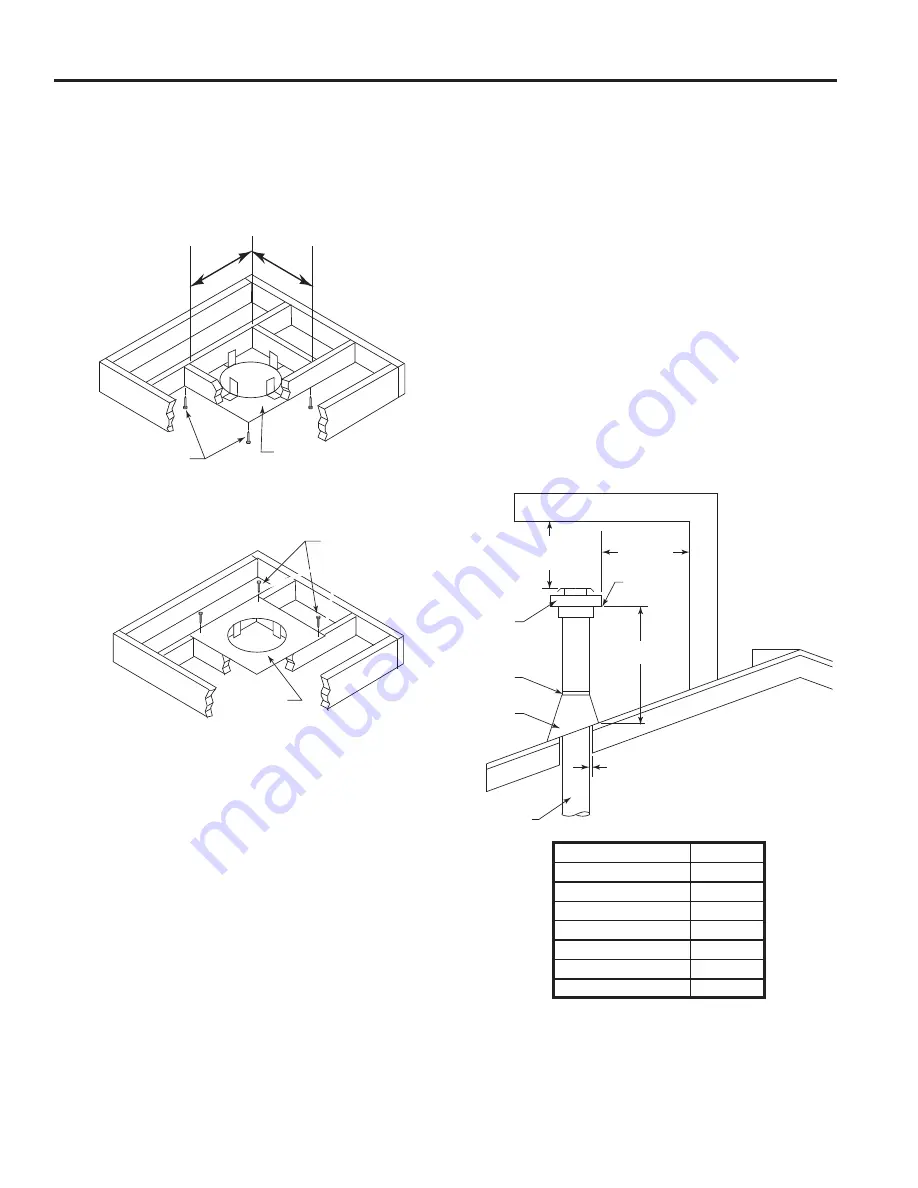
22
20306748
MLDV Series Gas Fireplace
VENTING INSTALLATION
Figure 34 -
If Area Above is a Room, Install Firestop
above Framed Hole as Shown
Firestop
Nails
FP1969
10
1
/
2
"
10
1
/
2
"
Figure 33 -
If Area Above is Not a Room, Install Firestop
above Framed Hole as Shown
Nails
Firestop
FP1970
Otherwise, install
fi
restop below the framed hole. The
fi
restop should be installed with no less than three (3)
nails per side.
Figure 34.
2. Assemble the desired lengths of pipe and elbows nec-
essary to reach from the burner system
fl
ue up through
the
fi
restop. Be sure pipe and elbow connections are
fully twist-locked.
Page 18, Figure 15.
3. Cut a hole in the roof using the locating hole as a center
point. (Cover any exposed open vent pipes before
cutting hole in roof). The 10
1
⁄
2
" x 10
1
⁄
2
" (267 x 267 mm)
hole must be measured on the horizontal. Actual length
may be larger depending on the pitch of the roof. There
must be a 1" minimum clearance from the vent pipe to
combustible materials. (Insulation should be considered
a combustible material). Frame the opening as shown
on
Page 18, Figure 16.
4. Connect a section of pipe and extend up through the
hole.
NOTE:
If an offset is needed to avoid obstructions, you
must support the vent pipe every three (3) feet. Use wall
straps for this purpose.
Figure 32
. Whenever possible, use
45° elbows instead of 90° elbows. The 45° elbow offers
less restriction to the
fl
ow of the
fl
ue gases and intake air.
5. Place
the
fl
ashing over the pipe section(s) extending
through the roof. Secure the base of the
fl
ashing to
the roof and framing with roo
fi
ng nails. Be sure roo
fi
ng
material overlaps the top edge of the
fl
ashing. There
must be a 1" clearance from the vent pipe to combus-
tible materials.
6. Continue to add pipe sections until the height of the
vent cap meets the minimum requirements below.
NOTE:
You must increase vent height for steep roof
pitches. Nearby trees, adjoining roof lines, steep pitched
roofs, and other similar factors may cause poor draft or
down-drafting in high winds. Increasing the vent height
may solve this problem.
NOTE:
If the vent pipe passes through any occupied areas
above the
fi
rst
fl
oor, including storage spaces and closets,
you must enclose pipe. You may frame and sheetrock the
enclosure with standard construction material. Make sure
to meet the minimum allowable clearances to combustibles.
Do not
fi
ll any of the required clearance spaces with
insulation.
2 ft.
Min.
2 ft. Min.
X
12
H*
FP1971
Figure 35 -
Minimum Chimney Clearance
Horizontal Overhang
Vertical Wall
Termination
Vent
Storm Collar
Flashing
Concentric
Vent Pipe
1" Minimum Clearance to
Combustibles
Lowest
Discharge
Opening
Roof Pitch
H (feet)
Flat to 6/12
1.0
Over 6/12 to 7/12
1.25
Over 7/12 to 8/12
1.5
Over 8/12 to 9/12
2.0
Over 9/12 to 10/12
2.5
Over 10/12 to 11/12
3.25
Over 11/12 to 12/12
4.0
*H - Minimum height from roof to
lowest discharge opening of vent
















































